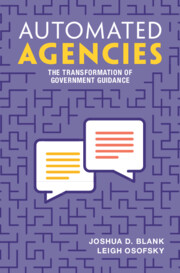Refine search
Actions for selected content:
48581 results in Computer Science
sL-approximation spaces capture sL-domains
-
- Journal:
- Mathematical Structures in Computer Science / Volume 35 / 2025
- Published online by Cambridge University Press:
- 04 April 2025, e4
-
- Article
- Export citation

Automated Agencies
- The Transformation of Government Guidance
-
- Published online:
- 03 April 2025
- Print publication:
- 10 April 2025
8 - Categories of Finite Derivation Type
- from Part II - Coherent Presentations
-
- Book:
- Polygraphs: From Rewriting to Higher Categories
- Published online:
- 18 March 2025
- Print publication:
- 03 April 2025, pp 180-191
-
- Chapter
- Export citation
11 - Termination of 3-Polygraphs
- from Part III - Diagram Rewriting
-
- Book:
- Polygraphs: From Rewriting to Higher Categories
- Published online:
- 18 March 2025
- Print publication:
- 03 April 2025, pp 237-248
-
- Chapter
- Export citation
13 - Term Rewriting Systems
- from Part III - Diagram Rewriting
-
- Book:
- Polygraphs: From Rewriting to Higher Categories
- Published online:
- 18 March 2025
- Print publication:
- 03 April 2025, pp 275-296
-
- Chapter
- Export citation
Acknowledgments for the Second Edition
-
- Book:
- Verification, Validation, and Uncertainty Quantification in Scientific Computing
- Published online:
- 22 March 2025
- Print publication:
- 03 April 2025, pp xv-xv
-
- Chapter
- Export citation
Appendix D - A Syntactic Description of Free n-Categories
- from Appendices
-
- Book:
- Polygraphs: From Rewriting to Higher Categories
- Published online:
- 18 March 2025
- Print publication:
- 03 April 2025, pp 572-583
-
- Chapter
- Export citation
Preface
-
- Book:
- Polygraphs: From Rewriting to Higher Categories
- Published online:
- 18 March 2025
- Print publication:
- 03 April 2025, pp xi-xx
-
- Chapter
- Export citation
Appendix A - A Catalogue of 2-Polygraphs
- from Appendices
-
- Book:
- Polygraphs: From Rewriting to Higher Categories
- Published online:
- 18 March 2025
- Print publication:
- 03 April 2025, pp 477-497
-
- Chapter
- Export citation
2 - Two-Dimensional Polygraphs
- from Part I - Fundamentals Of Rewriting
-
- Book:
- Polygraphs: From Rewriting to Higher Categories
- Published online:
- 18 March 2025
- Print publication:
- 03 April 2025, pp 22-44
-
- Chapter
- Export citation
Acknowledgments for the First Edition
-
- Book:
- Verification, Validation, and Uncertainty Quantification in Scientific Computing
- Published online:
- 22 March 2025
- Print publication:
- 03 April 2025, pp xvi-xviii
-
- Chapter
- Export citation
13 - Predictive Capability
- from Part IV - Model Validation and Predictive Capability
-
- Book:
- Verification, Validation, and Uncertainty Quantification in Scientific Computing
- Published online:
- 22 March 2025
- Print publication:
- 03 April 2025, pp 487-596
-
- Chapter
- Export citation
15 - Polygraphs
- from Part IV - Polygraphs
-
- Book:
- Polygraphs: From Rewriting to Higher Categories
- Published online:
- 18 March 2025
- Print publication:
- 03 April 2025, pp 316-326
-
- Chapter
- Export citation
7 - Coherence by Convergence
- from Part II - Coherent Presentations
-
- Book:
- Polygraphs: From Rewriting to Higher Categories
- Published online:
- 18 March 2025
- Print publication:
- 03 April 2025, pp 149-179
-
- Chapter
- Export citation
Part V - Homotopy Theory of Polygraphs
-
- Book:
- Polygraphs: From Rewriting to Higher Categories
- Published online:
- 18 March 2025
- Print publication:
- 03 April 2025, pp 379-380
-
- Chapter
- Export citation
19 - Polygraphic Resolutions
- from Part V - Homotopy Theory of Polygraphs
-
- Book:
- Polygraphs: From Rewriting to Higher Categories
- Published online:
- 18 March 2025
- Print publication:
- 03 April 2025, pp 381-391
-
- Chapter
- Export citation
15 - Maturity Assessment of Modeling and Simulation
- from Part V - Planning, Management, and Implementation Issues
-
- Book:
- Verification, Validation, and Uncertainty Quantification in Scientific Computing
- Published online:
- 22 March 2025
- Print publication:
- 03 April 2025, pp 627-666
-
- Chapter
- Export citation
Appendices
-
- Book:
- Polygraphs: From Rewriting to Higher Categories
- Published online:
- 18 March 2025
- Print publication:
- 03 April 2025, pp 475-476
-
- Chapter
- Export citation
Part I - Fundamentals Of Rewriting
-
- Book:
- Polygraphs: From Rewriting to Higher Categories
- Published online:
- 18 March 2025
- Print publication:
- 03 April 2025, pp 1-2
-
- Chapter
- Export citation
